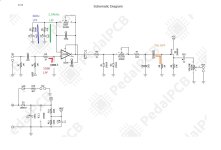Been playing with the RAT. Never really paid it a ton of attention because I found in nasal but thought I could toy with the filters and find my RAT.
Well, WTF is going on here?

So, R4-C4 create a filter for dogs. I've found some old RAT traces that actually have C4 as 10n. 16K makes a lot more sense as a corner freq. What's the chance that someone decoded that cap wrong 20 years ago everyone has copied everyone else since?
C9-R8 copy the input HPF. Again, a pretty useless corner freq. Turbo variant used 2M2 here, because we were missing that 3-6Hz content?
I get that the green and blue filters invert and form a low cut. I've seen this explained as one being a HPF and one being a LPF in more than one place. That's incorrect. But I'm only 85% there on whats going on here. 7% of it is why? Also, Does DIST add series resistance to R3/R5(in terms of the filter)? I wouldn't think so via C5. Anyway, I'm thinking that This C3/R5 is a point of contention for me. That 1kHz nasal quality that I despise after 3 minutes of playing. Some peoples cilantro, others soap...
I feel like we could do a bit of refining on the 7Hz HPF points as well.
Does the FET need to see that high of an impedance at R9?
Anyway curious to hear others thoughts and hopefully relearn some thing I forgot from school. No thevenin equations please.
Well, WTF is going on here?

So, R4-C4 create a filter for dogs. I've found some old RAT traces that actually have C4 as 10n. 16K makes a lot more sense as a corner freq. What's the chance that someone decoded that cap wrong 20 years ago everyone has copied everyone else since?
C9-R8 copy the input HPF. Again, a pretty useless corner freq. Turbo variant used 2M2 here, because we were missing that 3-6Hz content?
I get that the green and blue filters invert and form a low cut. I've seen this explained as one being a HPF and one being a LPF in more than one place. That's incorrect. But I'm only 85% there on whats going on here. 7% of it is why? Also, Does DIST add series resistance to R3/R5(in terms of the filter)? I wouldn't think so via C5. Anyway, I'm thinking that This C3/R5 is a point of contention for me. That 1kHz nasal quality that I despise after 3 minutes of playing. Some peoples cilantro, others soap...
I feel like we could do a bit of refining on the 7Hz HPF points as well.
Does the FET need to see that high of an impedance at R9?
Anyway curious to hear others thoughts and hopefully relearn some thing I forgot from school. No thevenin equations please.








